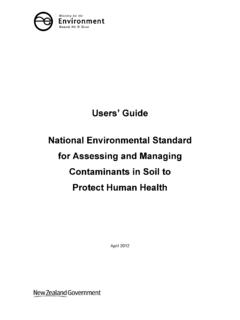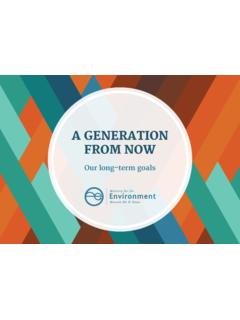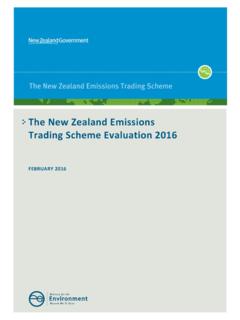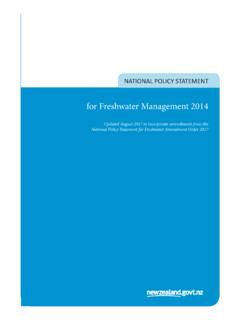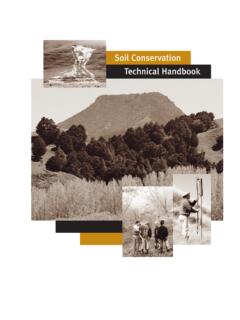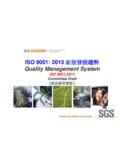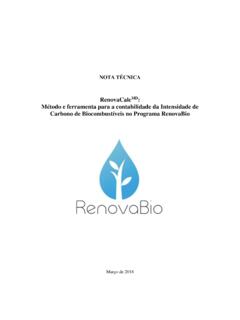Transcription of Guidance for Voluntary Greenhouse Gas Reporting …
1 Guidance for Voluntary Greenhouse Gas Reporting 2016 Using Data and Methods from the 2014 Calendar Year This report may be cited as: Ministry for the Environment. Guidance for Voluntary Greenhouse Gas Reporting 2016 : Using Data and Methods from the 2014 Calendar Year. Wellington: Ministry for the Environment. Published in December 2016 by the Ministry for the Environment Manat M Te Taiao PO Box 10362, Wellington 6143, New Zealand ISSN: 1174-8281 Publication number: ME 1281 Crown copyright New Zealand 2016 This document is available on the Ministry for the Environment s website: Guidance for Voluntary , Corporate Greenhouse Gas Reporting iii This is the ninth version of an annual publication. Each year the Ministry for the Environment will update this guide and associated tables with the latest emission factors for the given calendar year.
2 Changes to data and methodology for the 2016 Guidance General update: We recommend businesses and organisations use emissions factors that correlate to the year they are Reporting . For example, emissions factors published in this Guidance should be applied to activities in the 2016 calendar year or the 2016 /2017 financial year. Scope 1 emissions1 Stationary combustion emission factors for stationary combustion have been updated based on new figures for the 2014 calendar year. Transport fuels emission factors for transport fuels have been updated based on new figures for the 2014 calendar year. No estimates are available for marine diesel for the 2014 calendar year as the refinery has stopped making the marine diesel blend. If an organisation was using marine diesel, it is now likely to be using light fuel oil; so the corresponding emission factor for light fuel oil should be used instead.
3 Transport by distance emissions factors by engine size are now given in greater detail. In addition, emissions factors for petrol hybrids are now available. Taxis/rental cars have now been classed as scope 1. Emission factors for travel in taxis/rental cars have been updated based on new figures for the 2014 calendar year. Scope 2 Purchased electricity The electricity emission factor has been updated based on new figures for the 2014 calendar year. A time series of electricity emission factors for the period 1990 2014 are provided for 1990 to 2014 in the Microsoft Excel workbook. Scope 3 Transmission and distribution losses emission factors for transmission and distribution losses from purchased electricity and natural gas have been updated based on new figures for the 2014 calendar year.
4 Air travel To calculate air travel emissions it is now recommended that organisations use the International Civil Aviation Organization (ICAO) calculator. The latest emission factors for air travel from Department for Business, Energy & Industrial Strategy in the United Kingdom are still published if an organisation wishes to use these. Waste emission factors for waste to landfill with methane capture have been updated based on the latest data on landfill gas collection rates for the 2014 calendar year. The mixed waste factor has been updated based on national average composition data from New Zealand s Greenhouse Gas Inventory 1990-2014 (published in May 2016 ). Note: this guide is solely for use in Voluntary Greenhouse gas Reporting , and should not be used for Reporting under the New Zealand Emissions Trading Scheme.
5 1 An explanation of scope 1, 2 and 3 emissions are provided in section of this Guidance . iv Guidance for Voluntary , corporate Greenhouse gas Reporting Contents 1 Guidance on Reporting 1 Introduction 1 Who is this guide intended for? 1 Why is this information not for use in an emissions trading scheme? 2 What standards should I follow to report emissions? 2 What do the GHG Protocol and ISO 14064-1 cover? 2 What is the difference between these standards? 3 What information do I need? 3 Verification 3 Should I have my emissions inventory verified? 3 Who should verify my inventory? 4 2 Emission factors and methods context 5 Timing of emission factors and annual Reporting 6 The concept of scope 6 3 Emission factors and methods 8 Scope 1: Direct emissions 8 Stationary combustion of fuels 8 Transport fuels where fuel use data is available 10 Transport where no fuel data is available (based on distance travelled) 11 Taxis and rental cars 13 Refrigerants 14 Scope 2: Electricity indirect emissions 15 Purchased electricity 15 Scope 3: Other indirect emissions 16 Transmission and distribution line losses for purchased electricity 16 Transmission and distribution losses for distributed natural gas 17 Air travel 18 Waste to landfill 19 4 References 22 Appendix A.
6 Derivation of fuel emission factors 23 Appendix B: Methods for calculating emissions from refrigeration 26 Appendix C: Derivation of emission factors for waste to landfill 35 Appendix D: Landfills with gas collection systems 37 Guidance for Voluntary , Corporate Greenhouse Gas Reporting v Tables Table 1: Fuel combustion emission factors (fuels used for stationary combustion) 8 Table 2: Fuel combustion emission factors (transport fuels) 10 Table 3: Transport emission factors (based on distance travelled) 12 Table 4: Emission factors for travel in taxis and rental cars 13 Table 5: Emission factor for the consumption of purchased electricity 15 Table 6: Transmission and distribution line losses for purchased electricity 16 Table 7: Transmission and distribution losses for distributed natural gas 17 Table 9: Emission factors for air travel (based on distance travelled) 2014 18 Table 10: Emission factors for waste to landfill 21 Table 11: Underlying data used to derive the fuel combustion emission factors 2014 24 Table 12: Global warming potentials for CO2, CH4 and N2O (100-year time horizon) 25 Table 13: Default refrigerant charges and emission factors for refrigeration and air conditioning equipment 29 Table 14: Detailed 100-year global warming potentials for various refrigerant mixtures 30 Table 15: Derivation of emission factors for waste deposited to landfill 36 Table 16.
7 Landfills with gas collection systems 37 Guidance for Voluntary Greenhouse gas Reporting 1 1 Guidance on Reporting Introduction This guide has been prepared for Voluntary Greenhouse gas (GHG) Reporting , including emission factors. The guide encourages best practice in GHG Reporting and supports Voluntary GHG Reporting initiatives. It endorses the referenced Reporting frameworks such as The GHG Protocol and provides information (emission factors and methods) to enable organisations to apply them. This guide will be regularly updated to maintain consistency with international best practice and the New Zealand Government s national GHG inventory Reporting . Who is this guide intended for? This guide is for organisations that wish to voluntarily report GHG emissions on an organisational basis (sometimes called corporate or entity level) for their New Zealand operations.
8 This guide does not represent, or form part of, any mandatory Reporting framework or scheme. The emission factors and methods contained in this guide are for common emission sources for commercial organisations. This guide, however, also applies to industrial organisations that wish to voluntarily report on the same emission sources. These emission factors and methods are not appropriate for a full life-cycle assessment; or for the purposes of complying with the British Standards Institution PAS 2050 product carbon footprinting standard; or with the draft International Organization of Standardization (ISO) 14067 standard on the carbon footprint of products. These factors are not appropriate for life-cycle assessment as they only include direct emissions from activities, and do not include all sources of emissions required for a full life-cycle analysis.
9 The United Kingdom Department for Business, Energy & Industrial Strategy publish emission factors for a number of emission sources that take into account the life cycle of those In addition, The GHG Protocol Initiative has published standards for the calculation of life-cycle 2 3 2 Guidance for Voluntary Greenhouse gas Reporting Why is this information not for use in an emissions trading scheme? The information in this guide is intended to help organisations that want to report GHG emissions on a Voluntary basis. Organisations that are required to participate in a mandatory emissions trading scheme (ETS) will need to comply with the Reporting requirements specific to that scheme. The rules and regulations of those schemes will determine which emission factors and methods must be used to calculate and report emissions.
10 Organisations with obligations to report Greenhouse gases under mandatory schemes (including emissions trading), or who choose to participate in Voluntary GHG emission Reporting schemes, should check the rules and requirements of those schemes. The information in this guide may, however, be useful to organisations that have a Reporting obligation under an emissions trading scheme for a particular activity but still wish to publish comprehensive emission reports for their organisation on a Voluntary basis. Although this Reporting would not constitute compliance with an emissions trading scheme, it may help organisations prepare for, or understand how, an emissions trading scheme might impact on their business. What standards should I follow to report emissions?
